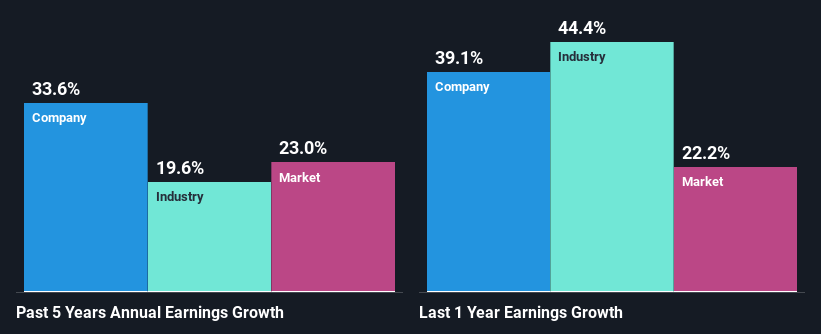- India
- /
- Aerospace & Defense
- /
- NSEI:DATAPATTNS
Should Weakness in Data Patterns (India) Limited's (NSE:DATAPATTNS) Stock Be Seen As A Sign That Market Will Correct The Share Price Given Decent Financials?
It is hard to get excited after looking at Data Patterns (India)'s (NSE:DATAPATTNS) recent performance, when its stock has declined 22% over the past three months. But if you pay close attention, you might find that its key financial indicators look quite decent, which could mean that the stock could potentially rise in the long-term given how markets usually reward more resilient long-term fundamentals. In this article, we decided to focus on Data Patterns (India)'s ROE.
Return on equity or ROE is an important factor to be considered by a shareholder because it tells them how effectively their capital is being reinvested. In short, ROE shows the profit each dollar generates with respect to its shareholder investments.
View our latest analysis for Data Patterns (India)
How To Calculate Return On Equity?
The formula for return on equity is:
Return on Equity = Net Profit (from continuing operations) ÷ Shareholders' Equity
So, based on the above formula, the ROE for Data Patterns (India) is:
14% = ₹1.9b ÷ ₹13b (Based on the trailing twelve months to June 2024).
The 'return' is the yearly profit. One way to conceptualize this is that for each ₹1 of shareholders' capital it has, the company made ₹0.14 in profit.
Why Is ROE Important For Earnings Growth?
So far, we've learned that ROE is a measure of a company's profitability. Depending on how much of these profits the company reinvests or "retains", and how effectively it does so, we are then able to assess a company’s earnings growth potential. Assuming everything else remains unchanged, the higher the ROE and profit retention, the higher the growth rate of a company compared to companies that don't necessarily bear these characteristics.
Data Patterns (India)'s Earnings Growth And 14% ROE
When you first look at it, Data Patterns (India)'s ROE doesn't look that attractive. Yet, a closer study shows that the company's ROE is similar to the industry average of 14%. Moreover, we are quite pleased to see that Data Patterns (India)'s net income grew significantly at a rate of 34% over the last five years. Considering the moderately low ROE, it is quite possible that there might be some other aspects that are positively influencing the company's earnings growth. Such as - high earnings retention or an efficient management in place.
As a next step, we compared Data Patterns (India)'s net income growth with the industry, and pleasingly, we found that the growth seen by the company is higher than the average industry growth of 20%.

Earnings growth is a huge factor in stock valuation. It’s important for an investor to know whether the market has priced in the company's expected earnings growth (or decline). Doing so will help them establish if the stock's future looks promising or ominous. If you're wondering about Data Patterns (India)'s's valuation, check out this gauge of its price-to-earnings ratio, as compared to its industry.
Is Data Patterns (India) Making Efficient Use Of Its Profits?
Data Patterns (India)'s ' three-year median payout ratio is on the lower side at 18% implying that it is retaining a higher percentage (82%) of its profits. So it looks like Data Patterns (India) is reinvesting profits heavily to grow its business, which shows in its earnings growth.
Along with seeing a growth in earnings, Data Patterns (India) only recently started paying dividends. Its quite possible that the company was looking to impress its shareholders. Existing analyst estimates suggest that the company's future payout ratio is expected to drop to 12% over the next three years. As a result, the expected drop in Data Patterns (India)'s payout ratio explains the anticipated rise in the company's future ROE to 18%, over the same period.
Conclusion
Overall, we feel that Data Patterns (India) certainly does have some positive factors to consider. Despite its low rate of return, the fact that the company reinvests a very high portion of its profits into its business, no doubt contributed to its high earnings growth. That being so, a study of the latest analyst forecasts show that the company is expected to see a slowdown in its future earnings growth. To know more about the company's future earnings growth forecasts take a look at this free report on analyst forecasts for the company to find out more.
New: Manage All Your Stock Portfolios in One Place
We've created the ultimate portfolio companion for stock investors, and it's free.
• Connect an unlimited number of Portfolios and see your total in one currency
• Be alerted to new Warning Signs or Risks via email or mobile
• Track the Fair Value of your stocks
Have feedback on this article? Concerned about the content? Get in touch with us directly. Alternatively, email editorial-team (at) simplywallst.com.
This article by Simply Wall St is general in nature. We provide commentary based on historical data and analyst forecasts only using an unbiased methodology and our articles are not intended to be financial advice. It does not constitute a recommendation to buy or sell any stock, and does not take account of your objectives, or your financial situation. We aim to bring you long-term focused analysis driven by fundamental data. Note that our analysis may not factor in the latest price-sensitive company announcements or qualitative material. Simply Wall St has no position in any stocks mentioned.
About NSEI:DATAPATTNS
Data Patterns (India)
Provides defense and aerospace electronics solutions in India.
High growth potential with excellent balance sheet.
Similar Companies
Market Insights
Community Narratives




